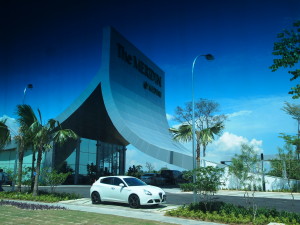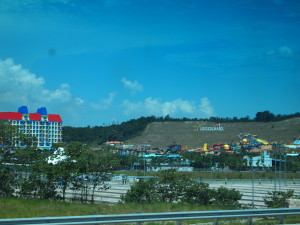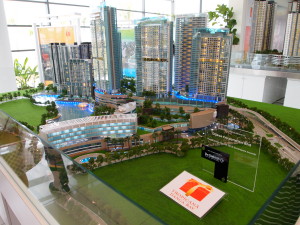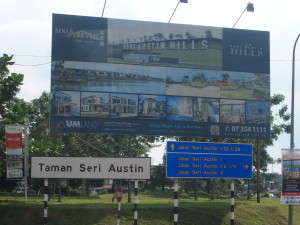Johor Bahru properties have never been hotter, and sometimes it seems that everyone, from the retiree dreaming of owning his own private garden to the young couple seeking a weekend escape from hectic Singapore looking for a 2nd home, to the 30-something white-collar office worker hoping to get rich quick from property investment, have been considering buying a home across the causeway.
On the surface JB (or ‘Iskandar Malaysia’) properties certainly look very attractive to the Singaporean buyer, offering luxury apartments or landed homes for up to 1/3 the price of what it would cost in Singapore’s market. Furthermore, highly publicized collaborations between not only the Singapore government on projects such as the a S$3.2 billion venture by CapitaLand and Temasek Holdings but also Legoland and international schools such as University of Southampton have increased investor confidence in Iskandar Malaysia’s future.
With several property agent friends already actively marketing homes across the border, I’ll admit I myself have been bitten by the JB bug, and lately I have been making regular trips down to check out not only the eating (durian Phong Peah, anyone?) shopping and entertainment scene but also the latest new developments going on in the area. Without a doubt, JB certainly has a lot to offer the average Singaporean, especially so given that exchange rates have never been more favorable at S$1=RM2.5 (as of Aug 2013). However, the big question is: is now the time to buy? With Iskandar Malaysia property prices having already risen 5 times since 2006, I believe investors have been overly optimistic on the future capital appreciation of properties up north.
Here are the reasons why I think it would be wise to wait before rushing into committing to an Iskandar home.
An MRT linking Singapore to JB by 2020 – A Realistic Timeline?
Reports in the media have stated that a rapid train linking Singapore to JB are well in the works, with Malaysia’s Foreign Minister Datuk Seri Anifah Aman and Singapore having already agreed to go ahead with the Rapid Transit System (RTS). However, while Malaysian Prime Minister Najib Razak and Prime Minister Lee Hsien Loong have told reporters in Singapore that 2020 will be the target year where the RTS will be fully completed, I am skeptical that this is a realistic timeline, given that the actual train station locations in JB is not even confirmed.
For comparison purposes, even the newest Circle Line in Singapore took 10 years to complete, with partial openings in 2009 and full operational status only reached in 2011. And this was a project fully integrated with the existing MRT system and entirely managed within the Singapore borders and by the highly efficient Singapore government. One can only imagine the possible delays that could be caused with two governments having a hand in this major project, both with a history of bitter conflicts and disputes, trying to come to agreement on something as major as a inter-linking train system. Just for comparison purposes, discussions between France and the United Kingdom (also neighboring countries just like Singapore and Malaysia) for a cross-Channel rapid train started as early as 1802, but political complications delayed the process, with completion only achieved 192 years later in 1994! Similarly, property investors in JB could end up ‘等久久’, or wait long long for the Singapore-JB MRT to happen.
Domination by Singapore Buyers
Singapore buyers have always been prominent in the JB market, although less common and until recently, mostly restricted to those with close ties to Malaysia with relatives still living in the area. However, rapidly rising property prices and an expanding population in Singapore have pushed Singaporeans to look into the JB property market, who are responsible for much of the new luxury developments in areas such as Bt Indah, Danga Bay and Medini.
Statistics show that Singaporeans are believed to make up more than 90% of the Iskandar new build property market. However, tighter government controls on Total Debt Servicing Ratio (TDSD) in Singapore means that middle-income earners (which mass-market developers in JB count on) will have difficultly taking out mortgages for second homes in Iskandar, particularly if they already have an existing HDB housing loan. And if this large group stop buying Iskandar properties, there will be a glut in the market of not only new builds but also recently completed properties priced at around RM$500,000, the minimum investment level for foreign nationals.
Even from this middle-income group, demand for JB properties is not as stable as it seems. With stiff competition for investor dollars from developers from new and emerging international property markets such as Phuket, Bali, Manila to newer players nearby such as Myanmar, and even within Malaysia itself in Penang and KL, properties in Iskandar Malaysia that struggle to offer strong rental yields may face difficulty appealing to the seasoned investor.
New Developments – New only for Now
New build condo developments in Iskandar make up a significant amount of supply on the market – but also tend to be significantly more expensive that existing housing in the area. When I searched online for properties in the Bt Indah area, I found that a 15-year old terrace house with its own garden plot was going for RM500 psf, while a nearby new development was asking more than double that. With thousands of new condo units to be completed within the next 3 years, long-term prices could follow the trend of that of older units in the area.
Furthermore, almost all of the greatest price appreciation in Iskandar are in areas close to the Woodlands Causeway, the Tuas 2nd Link or close to major malls such as AEON. Ironically, it seems that overnight the previously notorious Jalan Wong Ah Fook by Citylink Mall known for its motorcycle drive-by handbag snatchings has turned from “Isn’t that a high-crime area that Singaporeans should avoid?” to one of the hottest in-demand areas. However, overtime, as new developments in hot areas complete and enter the market, prices of previously new units will still fall to become closer to that of older developments, meaning that average prices will fall in relative terms.
Favorable Exchange Rates
The Singapore dollar has never been stronger, hitting a 15-year high against the ringgit yesterday when the exchange rate hit S$1 = RM2.5479 in July 2013, which was reportedly the strongest the Singdollar has been against the ringgit since early 1998. This has contributed not only to an increasing number of Singaporean shoppers driving across the Causeway over the weekend to grocery shop but has also fueled interest in Malaysia properties. On the flipside, this also makes Malaysia properties exposed to currency risks, should the Singapore dollar depreciate or the Malaysia ringit rise. Not forgetting that JB locals, which make up a larger proportion of those looking for homes are also affected – while property prices have been on the increase, average salaries have not risen proportionately for locals in JB, subsequently affecting their ability to take out larger mortgages and their ability to afford the more expensive JB homes.
Johor Government Intervention: Higher Property Taxes & a RM$1 million Price Floor
Everywhere in the world, there is no lack of evidence how increases in property taxes can make or break its local property market. Local government plans for increases in property taxes in JB have already been announced, but until further information is released, the amount of increase remains uncertain. Even in Singapore and Hong Kong, there is no lack of data to show that government cooling measures has greatly impacted the property market. Despite the Malaysian Prime Minister Najib Razak’s verbal commitment to developing the Iskandar region, in my opinion not enough has been done to introduce an open system of clarity and openness which would build the foundation for steady growth in Iskandar. The sudden announcement but uncertain increase in property tax for foregin investors risks putting off buyers. Not to mention the announcement in January 2013 that the Johor government is currently considering doubling the floor price for properties bought by foreigners to RM1 million from the current RM500,000, which will hit middle-income buyers the most.
==
Those looking at investing in JB should certainly keep the advantages of the proximity to Singapore and the relatively affordable prices in mind, but should not forget that inherent problems such as lack of safety and daylight robberies continue to plague JB, despite announced plans on the Malaysia government’s side to beef up police patrols. Increased property taxes and a doubling of the price ceiling for foreigners looming on the horizon could push future buyers away. In the worst-case scenario, all it could take would be for a highly-publicized gristly robbery attack on an elderly retired Singaporean couple living in JB to cause mass panic and sell-off of JB property, which would lead to increased supply and falling demand . So while I myself long for the wide open spaces, cheaper cars, food and entertainment that a nearby second home is Iskandar could bring me, for now I will take the wait-and-see approach and stick to the bi-weekly shopping visit across the border … until property prices there start to come down.




